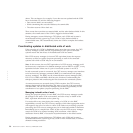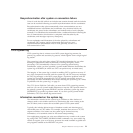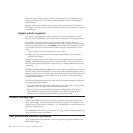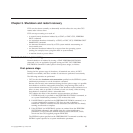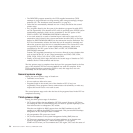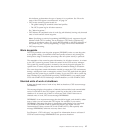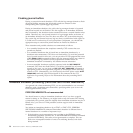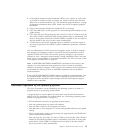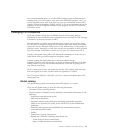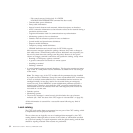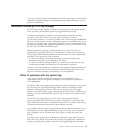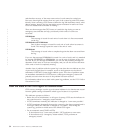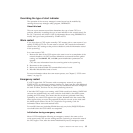
Flushing journal buffers
During a successful normal shutdown, CICS calls the log manager domain to flush
all journal buffers, ensuring that all journal records are written to their
corresponding MVS system logger log streams.
During an immediate shutdown, the call to the log manager domain is bypassed
and journal records are not flushed. This also applies to an immediate shutdown
that is initiated by the shutdown-assist transaction because a normal shutdown has
stalled. Therefore, any user journal records in a log manager buffer at the time of
an immediate shutdown are lost. This does not affect CICS system data integrity.
The system log and forward recovery logs are always synchronized with regard to
I/O and unit of work activity. If user journal data is important, you should take
appropriate steps to ensure that journal buffers are flushed at shutdown.
These situations and possible solutions are summarized as follows:
v In a controlled shutdown that completes normally, CICS ensures that user
journals are flushed.
v In a controlled shutdown that is forced into an immediate shutdown by a
shutdown-assist transaction, CICS does not flush buffers. To avoid the potential
loss of journal records in this case, you can provide a PLTSD program that issues
a SET JOURNAL FLUSH command to ensure that log manager buffers are written to
the corresponding log streams. PLTSD programs are invoked before an
immediate shutdown is initiated by the shutdown-assist transaction.
v In an uncontrolled shutdown explicitly requested with the SHUT IMMEDIATE
command, CICS does not flush buffers. To avoid the potential loss of journal
records in this case, you can issue an EXEC CICS WAIT JOURNALNAME command at
appropriate points in the application program, or immediately before returning
control to CICS. (Alternatively, you could specify the WAIT option on the WRITE
JOURNALNAME command.) See the description of the command in the CICS
Application Programming Reference for information about the journaling WAIT
option.
Immediate shutdown processing (PERFORM SHUTDOWN IMMEDIATE)
As a general rule when terminating CICS, you are recommended to use a normal
shutdown with a shutdown assist transaction, specifying either your own or the
CICS-supplied default, CESD.
PERFORM IMMEDIATE not recommended
You should resort to using an immediate shutdown only if you have a special
reason for doing so. For instance, you might need to stop and restart CICS during
a particularly busy period, when the slightly faster immediate shutdown may be of
benefit. Also, you can use VTAM persistent sessions support with an immediate
shutdown.
You initiate an immediate shutdown by a CEMT, or EXEC CICS, PERFORM
SHUTDOWN IMMEDIATE command. Immediate shutdown is different from a
normal shutdown in a number of important ways:
1. If the shutdown assist transaction is not run (that is, the SDTRAN system
initialization parameter specifies NO, or the PERFORM SHUTDOWN command
specifies NOSDTRAN), user tasks are not guaranteed to complete. This can
lead to an unacceptable number of units of work being shunted, with locks
being retained.
28 CICS TS for z/OS 4.1: Recovery and Restart Guide



